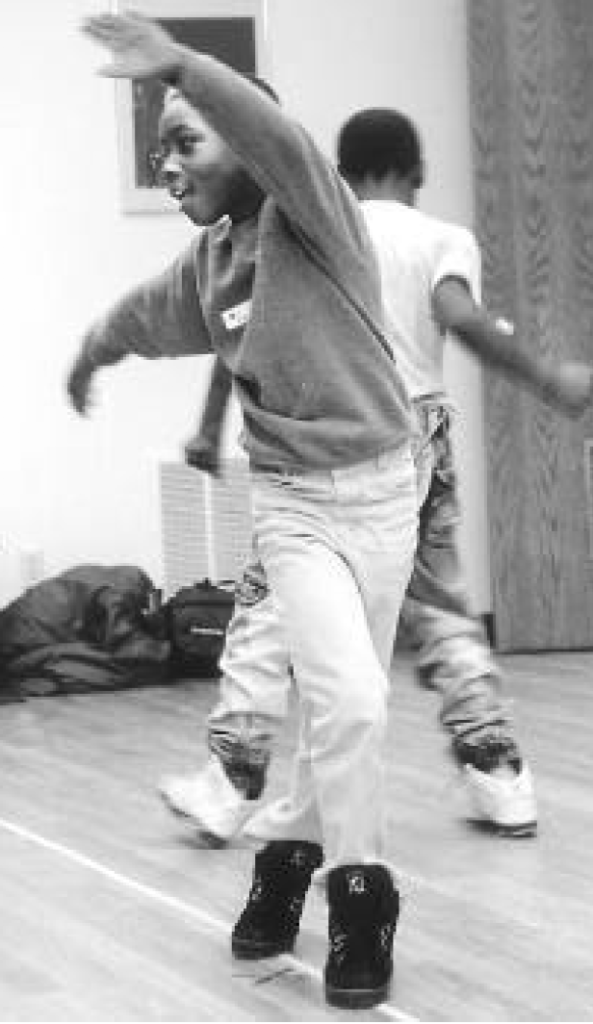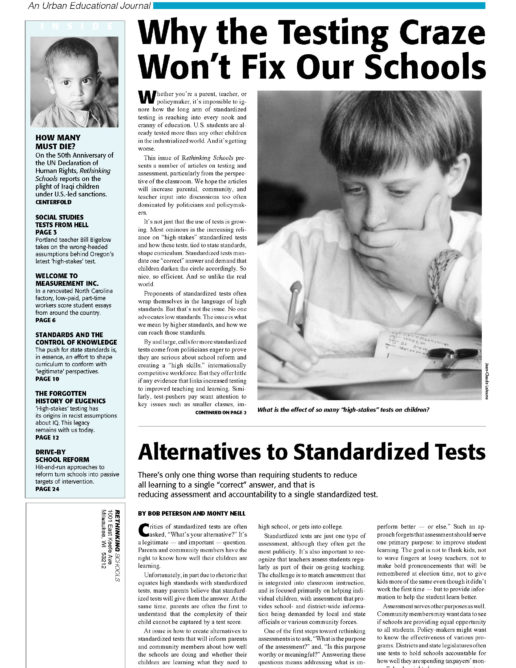Dancin’ Circles
Even the most rigid of state testing plans will never be able to control what every child does or thinks or writes. There may be hope.

Last March, I stood in front of my classroom and tore the plastic from a stack of papers. On those papers were printed the topic my sixth-graders, and thousands of other Illinois sixth-graders, would spend the next 40 minutes writing about.
We all are graded on the results — the students, teachers, and schools. Under state law, we all must take the Illinois Goals Assessment Program tests, the IGAPS, to ensure that across the state, all students take the same test at the same time, write about the same topic, and follow the same rules — so that everyone and everything is the same.
The IGAP is law because the easiest way for politicians to pretend they care about education is to stand up and declare that students are not learning because teachers can’t teach and the schools are rotten, and we are gonna fix it by … by taking a test. Not that those politicians have any idea what we should test for, or how we would test for it if we knew. But that does not matter. Demands for more testing sound good on TV. So the Illinois legislature told our state bureaucrats to design tests in reading, writing, math, science, and social studies, and make everyone take them for two weeks in March.
By law, Illinois students learn to write by the numbers. The first paragraph of a paper must do this this this this and this, the three main body paragraphs must do that that that that and that, and the conclusion paragraph must begin with two “thises,” followed by three “thats,” and end with an exciting “this.”
I am not making this — or that — up.
And those are just the rules for a persuasive-type paper. We learn different rules for expository and narrative papers. There’s just one problem. This is not how people write. This is how people fill out tax forms.The kids hate it, especially the best writers.
“Mr. Ferri,” they ask, “haven’t you ever heard of foreshadowing?” “If I want to tell my story a different way, why can’t I?”
I explain that our state legislature has determined that we must have standards of instruction. The children look at me like I need to blow my nose.
I tell them about basics of form that once mastered can be improvised on. They keep looking at me.
I try to convince them that these are efficient formulas for clear writing. They keep looking.
Finally I say, “Look, neither of us has any choice here. You have to take these tests, I have to give them, and some poor soul in North Carolina has to read and grade 500 of them a day. They have a list of the rules you learned for writing each kind of essay. If you don’t follow a rule, they take points from your score. They don’t care what you write. They only care about the rules. If you don’t follow the rules, you get a bad score. The scores are published in the paper. If our scores aren’t good, then people won’t think our schools are good, and they won’t want to move here, which will make the real estate people mad, and they will yell at the school board, who will yell at the superintendent, who will yell at the principal, who will yell at me. This is not about writing; this is about not getting yelled at.”
This the kids understand.
On the day of the test, each student receives an IGAP test booklet. On the front page, students must record their name, grade, student ID number, date of birth, ethnicity, and god knows what else. Each letter or number goes in a box; under the box, with a number-2 pencil, the student must fill in a circle that corresponds to that letter or number or ethnicity. If the boxes and circles aren’t filled out right, or the marks aren’t dark enough, the machines can’t read them, and we get yelled at.
We filled out the information pages on the day before we began the tests. After the students were finished, the pages looked as if they had been used to line bird cages. Random marks were everywhere. So my teaching partner and I stuck Post-it notes on the worst of them saying, “Print your name more clearly.” Or, “Fill in circles under date of birth.” Or, “Darken circles.”
The morning of the first writing test my students sat vacant and resigned, like Pickett’s Virginians at Gettysburg waiting for the charge. I picked up the packet of prompt pages with the writing topic printed on them. I broke the plastic seal and handed them out. Then we handed out the students’ test packets, some sporting Post-it reminders to “Print your name more clearly,” or “Darken circles.”
I stood in front of the class and read from my booklet. By law, I recited the exact same words that thousands of other sixth-grade teachers would read those mornings. “This is the test I told you about,” I began. “You will have 40 minutes to” …. blah blah blah. I ended with, “Turn over the prompt page, read what the topic is, and begin writing. Good luck.”
I wasn’t bound by law to say good luck, but I thought it might be OK to wing it there.
The topic was, “Should students be required to wear uniforms to school?” The children picked up their pencils, took a breath, and wrote. The only sound was the turning of pages, the scratching and the sharpening of pencils.
As required by law, I announced when 20 minutes were left, then five, then when time was up. We collected the prompt pages because they must be counted and sent back to the state. We collected the test packets, and I set them on my desk while the students stretched and talked quietly. Then I heard Duane ask Becky, “What did you write about?”
“Well, I wrote about uniforms,” Becky answered. “We all did, it said so on the paper.”
“Mine didn’t say that,” Duane said. “Mine said to write about dancin’ circles.”
Becky and I both said, “What? What did you write about?”
“I wrote about dancin’ circles,” Duane responded. “Here, I’ll show you.”
I reached for the pile of prompt pages, but Duane was already rummaging through the stack of test booklets. Becky said, “Those didn’t say what to write about!”
“Mine did,” Duane answered. He pulled his test booklet out of the stack and pointed to the Post-it stuck to the front page. On that Post-it I had written, “Darken circles.”
“See, right here, it says “Dancin’ circles,’ ” Duane said. “So that’s what I wrote about.”
That morning, thousands of sixth-graders across Illinois sat at their desks, curled themselves around their pencils, stuck their tongues between their teeth, and wrote five-paragraph essays about uniforms. All, except one. His essay began, “Well, I never thought much about dancin’ circles before today, but if that’s what you want to know about, well, here goes.”
Somewhere in North Carolina, some poor soul will reach into the stack of 500 essays they will read that day; 499 of them will be about wearing uniforms, and one will not. I would love to watch her face when she reads it.
There may still be hope.

